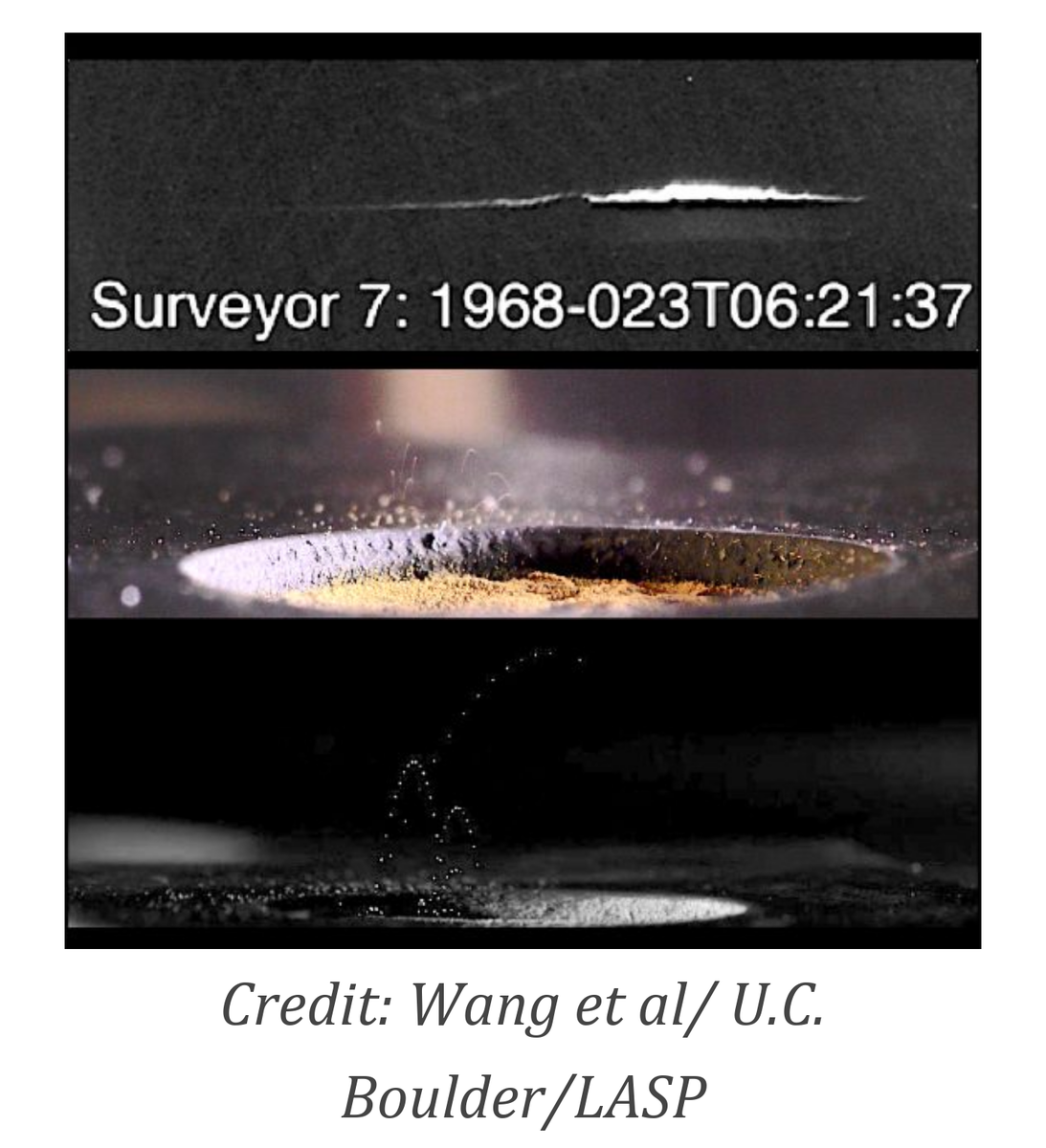ザ・サンダーボルツ勝手連 [Floating on an Electric Breeze エレクトリック・ブリーズ(電気風)に浮かぶ]
[Floating on an Electric Breeze エレクトリック・ブリーズ(電気風)に浮かぶ]
Stephen Smith March 2, 2017Picture of the Day

Top: Surveyor 7 image. Middle: particles “smoothed” by dust movement. Bottom: dust particles leap off the table when exposed to laboratory plasmas.
上:サーベイヤー(測量士)7の画像。 中央:塵の動きによって「滑らかに」なった粒子。 下:実験室のプラズマにさらされると、ダスト粒子がテーブルから飛び出します。
―――――――――
Mar 2, 2017
電気はさまざまな形で現れます。
最近のプレスリリースによると、コロラド大学の科学者たちは、月の縁にかすかな輝きがある理由を知っていると考えています:
静電気です。
〈https://sservi.nasa.gov/articles/electrostatic-dust-transport-reshapes-surfaces-of-airless-planetary-bodies/〉
実験室での実験により、プラズマまたは紫外線にさらされると、ほんの数ミクロンのダスト粒子がテーブルから飛び出したことが確認されました。
発表によると、同じ電気的活動が、ロゼッタ彗星探査機が67P /チュリモフ・ゲラシメンコ彗星を取り巻く大量の「ふわふわした」ダスト粒子を発見した理由である可能性があると述べています。
または、NEAR-シューメーカー人工衛星が小惑星エロスに塵の「池」を見つけた理由です。
月の地平線から100キロ上に時々見られる輝くもやがあります。
月には大気がないので、何が霞の原因であるかについては、長年の謎です。
しかしながら、月の昼側と夜側の電荷差が、負に帯電した夜側からより正に帯電した太陽に照らされた側に流れるイオン「風」を生成する可能性があります。
日中の明るい表面の負電荷は、光電現象によって緩和されますが、一方では、暗闇の中で蓄積して静電気を形成する傾向があります。
2つの半球間の電荷の変動は、1000ボルトを超える電圧が測定されています。
その電界は輸送メカニズムである可能性があります。
地球は、月の軌道をはるかに超えて広がる磁場に囲まれています。
イオン・ストリームがマグネト・テイル内の荷電プラズマを反発するため、太陽から遠ざかっています、オタマジャクシの形をした、磁気の殻を宇宙空間に形成します。
1998年にケープ・カナベラルから打ち上げられた月探査機は、地球から外側に伸びている磁気圏尾部を通過するときに高電圧の変化を検出しました。
〈https://www.lpi.usra.edu/lunar/missions/prospector/〉
マグネト・テイルは実際には、惑星を包むプラズマ・シースの一部です。
月は満月の段階で月に1回通過します;
その通過の間に電気的差異が発生することがわかりました。
地球の電離プラズマを通過する月の動きは、月のレゴリス(砂粒)の物質に影響を与えます。
電子が蓄積し、超微細ダスト粒子に負の電荷を発生させ、それらを互いに反発させ、表面からドリフトさせます。
地球のプラズマ・シートは、太陽からの電気の曝露を受けて形状と電力が変化します。
これは、フィールドに周期性があるため、「はためき」として説明される場合があります。
これは、月が単純にマグネト・テイルを通過するのではなく、しかし、その電荷は毎月の出会いの間に数回表面を磨き(ブラシ)ます。
電気は宇宙に存在し、その影響は環境によって変化します。
浮遊する塵と月のかすかな輝きは、それは大気がないので、電荷はより大きな推進力を持っているからである可能性が最も高い。
スティーブン・スミス
ウィリアム・トンプソンへの帽子チップ
―――――――――
Mar 2, 2017
Electricity manifest in many ways.
電気はさまざまな形で現れます。
According to a recent press release, scientists from the University of Colorado think that they know why there is a faint glow on the lunar limb: static electricity.
最近のプレスリリースによると、コロラド大学の科学者たちは、月の縁にかすかな輝きがある理由を知っていると考えています:
静電気です。
〈https://sservi.nasa.gov/articles/electrostatic-dust-transport-reshapes-surfaces-of-airless-planetary-bodies/〉
Laboratory experiments confirmed that dust particles, no more than a few microns across, leaped off the table when exposed to plasmas or ultraviolet light.
実験室での実験により、プラズマまたは紫外線にさらされると、ほんの数ミクロンのダスト粒子がテーブルから飛び出したことが確認されました。
The announcement states that the same electrical activity could be why the Rosetta Cometary Probe found a large quantity of “fluffy” dust particles surrounding Comet 67P/Churyumov–Gerasimenko.
発表によると、同じ電気的活動が、ロゼッタ彗星探査機が67P /チュリモフ・ゲラシメンコ彗星を取り巻く大量の「ふわふわした」ダスト粒子を発見した理由である可能性があると述べています。
Or, why the NEAR-Shoemaker satellite found “ponds” of dust on Asteroid Eros.
または、NEAR-シューメーカー人工衛星が小惑星エロスに塵の「池」を見つけた理由です。
There is a glowing haze sometimes seen 100 kilometers above the Moon’s horizon.
月の地平線から100キロ上に時々見られる輝くもやがあります。
It is along-standing mystery as to what causes the haze, since there is no atmosphere on the Moon.
月には大気がないので、何が霞の原因であるかについては、長年の謎です。
However, electric charge differential between the day and night side of the Moon might generate an ionic “wind” flowing from the negatively charged night side into the more positively charged sunlit side.
しかしながら、月の昼側と夜側の電荷差が、負に帯電した夜側からより正に帯電した太陽に照らされた側に流れるイオン「風」を生成する可能性があります。
A negative charge on the bright surface during daylight is moderated by the photoelectric phenomenon, while it tends to build up in the darkness, forming static electricity.
日中の明るい表面の負電荷は、光電現象によって緩和されますが、一方では、暗闇の中で蓄積して静電気を形成する傾向があります。
The charge variation between the two hemispheres has been measured at more than 1000 volts.
2つの半球間の電荷の変動は、1000ボルトを超える電圧が測定されています。
That electric field could be the transport mechanism.
その電界は輸送メカニズムである可能性があります。
Earth is surrounded by a magnetic field that stretches well beyond the Moon’s orbit.
地球は、月の軌道をはるかに超えて広がる磁場に囲まれています。
It is elongated away from the Sun because its ion stream repels charged plasma within the magnetotail, forming a tadpole-shaped, magnetic shell in space.
イオン・ストリームがマグネト・テイル内の荷電プラズマを反発するため、太陽から遠ざかっています、オタマジャクシの形をした、磁気の殻を宇宙空間に形成します。
The Lunar Prospector, launched from Cape Canaveral in 1998, detected a high voltage change as it passed through the magnetotail extending outward from Earth.
1998年にケープ・カナベラルから打ち上げられた月探査機は、地球から外側に伸びている磁気圏尾部を通過するときに高電圧の変化を検出しました。
〈https://www.lpi.usra.edu/lunar/missions/prospector/〉
The magnetotail is actually part of a plasma sheath enveloping the planet.
マグネト・テイルは実際には、惑星を包むプラズマ・シースの一部です。
The Moon passes through it once a month during full moon phase;
the electric differential was found to occur during that passage.
月は満月の段階で月に1回通過します;
その通過の間に電気的差異が発生することがわかりました。
The movement of the Moon through Earth’s ionized plasma affects materials in the lunar regolith.
地球の電離プラズマを通過する月の動きは、月のレゴリス(砂粒)の物質に影響を与えます。
Electrons accumulate, producing a negative charge on the ultra-fine dust particles, causing them to repel each other and drift off the surface.
電子が蓄積し、超微細ダスト粒子に負の電荷を発生させ、それらを互いに反発させ、表面からドリフトさせます。
Earth’s plasma sheet changes shape and power as it is bombarded by electricity from the Sun.
地球のプラズマ・シートは、太陽からの電気の曝露を受けて形状と電力が変化します。
It is sometimes described as a “flag waving” because of some periodicity in the field.
これは、フィールドに周期性があるため、「はためき」として説明される場合があります。
This means that the Moon does not simply pass through the magnetotail once and briefly, but that electric charges will brush the surface several times during each monthly encounter.
これは、月が単純にマグネト・テイルを通過するのではなく、しかし、その電荷は毎月の出会いの間に数回表面を磨き(ブラシ)ます。
Electricity exists in space and its effects are varied, depending on the environment.
電気は宇宙に存在し、その影響は環境によって変化します。
Levitating dust and the Moon’s faint glow are most likely because it has no atmosphere, so electric charges have greater impetus.
浮遊する塵と月のかすかな輝きは、それは大気がないので、電荷はより大きな推進力を持っているからである可能性が最も高い。
Stephen Smith
スティーブン・スミス
Hat tip to William Thompson
ウィリアム・トンプソンへの帽子チップ